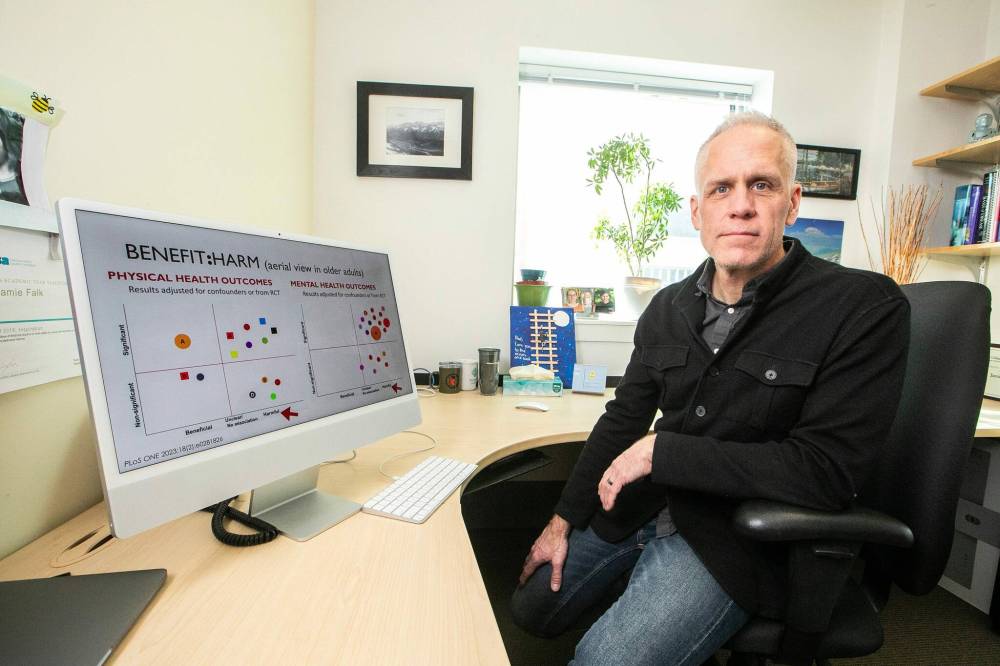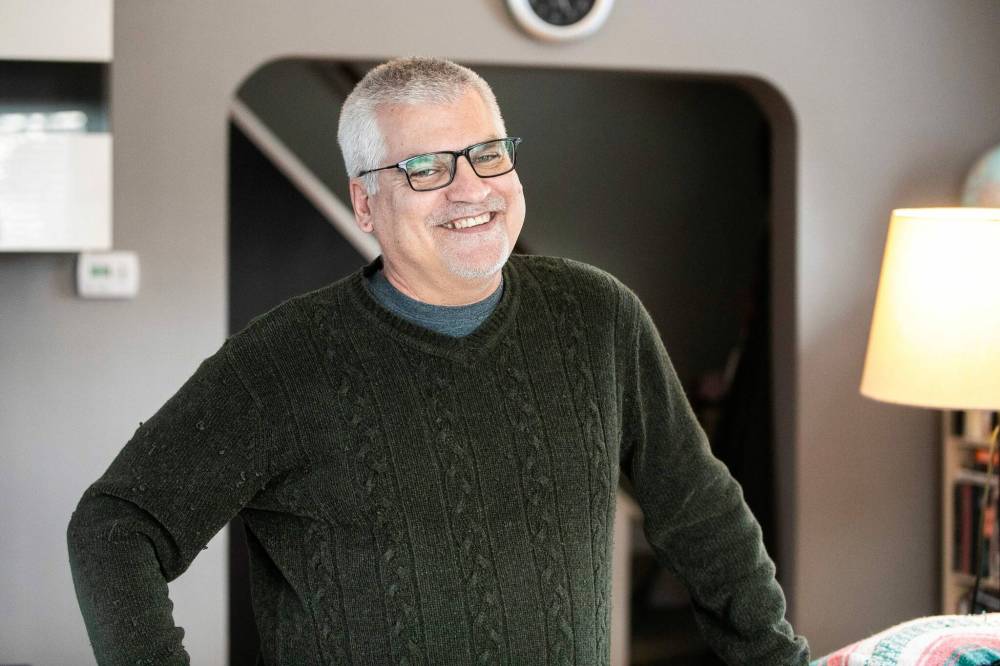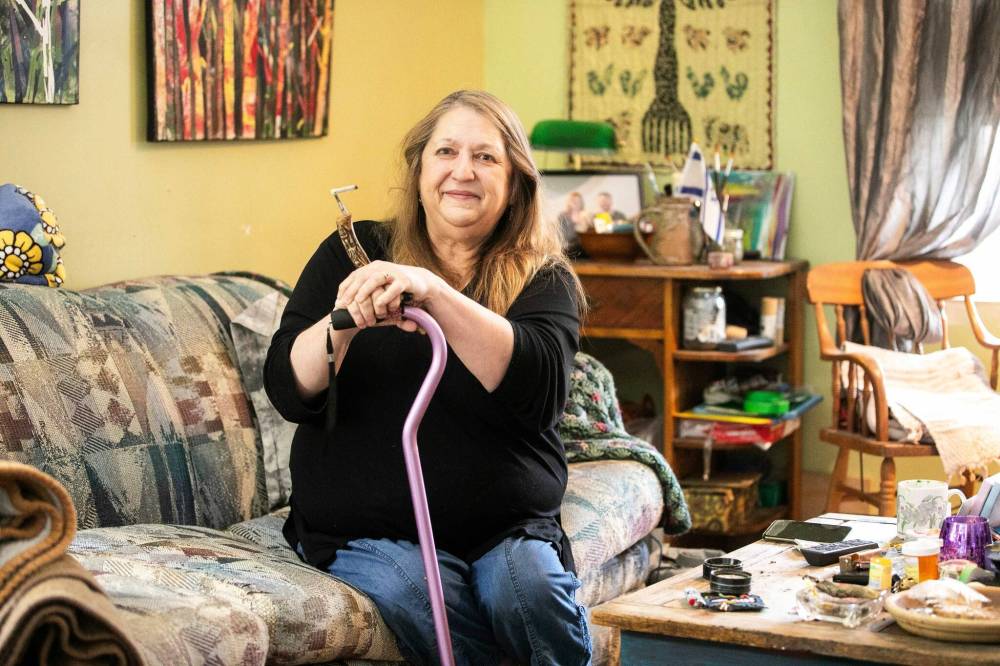Golden-age ganja Seniors make up the fastest growing segment of Canadian cannabis consumers, but health professionals urge older users to be wary of anecdotal claims and unwelcome or risky side effects
Read this article for free:
or
Already have an account? Log in here »
To continue reading, please subscribe:
Monthly Digital Subscription
$0 for the first 4 weeks*
- Enjoy unlimited reading on winnipegfreepress.com
- Read the E-Edition, our digital replica newspaper
- Access News Break, our award-winning app
- Play interactive puzzles
*No charge for 4 weeks then price increases to the regular rate of $19.00 plus GST every four weeks. Offer available to new and qualified returning subscribers only. Cancel any time.
Monthly Digital Subscription
$4.75/week*
- Enjoy unlimited reading on winnipegfreepress.com
- Read the E-Edition, our digital replica newspaper
- Access News Break, our award-winning app
- Play interactive puzzles
*Billed as $19 plus GST every four weeks. Cancel any time.
To continue reading, please subscribe:
Add Free Press access to your Brandon Sun subscription for only an additional
$1 for the first 4 weeks*
*Your next subscription payment will increase by $1.00 and you will be charged $16.99 plus GST for four weeks. After four weeks, your payment will increase to $23.99 plus GST every four weeks.
Read unlimited articles for free today:
or
Already have an account? Log in here »
Hey there, time traveller!
This article was published 14/03/2025 (259 days ago), so information in it may no longer be current.
Sherry Eastwood enjoys cannabis-laced gummies and the occasional brownie, though it’s not something she partakes in with any regularity.
She’s always careful, imbibing roughly once a month and never a large amount. It makes her feel good, she says, and helps with sleep.
“It’s sort of like you get this carefree feeling, nothing really matters anymore. It’s better than drinking. You just feel happy, you start laughing about stupid things and you eat snacks,” Eastwood, 70, says with a chuckle.
Eastwood is part of a small but growing cohort of seniors using cannabis in Canada. The number of users 65 and older has been increasing since the Trudeau government legalized marijuana in 2018, now making up about seven per cent of all users, according to Statistics Canada.
Many cite pain relief as a reason for using cannabis, along with promoting sleep and treating anxiety.
But increased experimentation comes with a warning from health experts. A 2024 Ontario-based study found the number of cases of cannabis poisoning is increasing among seniors.
Meanwhile, mixing the use of cannabis with other age-related drugs has not been not widely studied.
“It’s sort of like you get this carefree feeling, nothing really matters anymore. It’s better than drinking. You just feel happy.”–Sherry Eastwood
Eastwood, a retired education assistant, used cannabis as a teenager, but stopped when she became pregnant and had a child at 20. But in her 60s, once it was legalized, she thought she would try it again, grateful she could shop at a neighbourhood store.
However, she admits not everyone is as open-minded, despite legalization.
“Because it was illegal at one time, people’s mentality hasn’t changed. People drink; do they feel shocked? Usually not. But say, ‘I’m going to have a joint or do some gummies with you,’ they’re shocked,” she says.
Canada became the second country to legalize cannabis, to the delight of some and consternation of others. Since October 2018, retail stores have spread throughout the province, in nearly every village, town and city.
People aged 19 and over can enter any of Manitoba’s 226 licensed retailers — including 133 shops in Winnipeg — to make a purchase.
These days, cannabis products are wide-ranging and include edibles, vapes, pre-rolled, drops and dried flowers, among others. There’s an overwhelming plethora of items with clever names and colourful packaging of every size and shape.
For baby boomers and gen-Xers, cannabis use was simple and basic back in the day — you knew a guy — and the common green herb was for smoking or baking into brownies.
Nowadays, cannabis comes in an assortment of forms, like fast-acting, sweet-and-salty popcorn, beef jerky, and ketchup or salt-and-vinegar chips infused with THC (tetrahydrocannabinol), the main psychoactive component of marijuana.
MIKAELA MACKENZIE / FREE PRESS
Accompanying supplies include bongs, vaporizers, grinders, pipes, bubblers, candles and on it goes.
Whether you’re looking to use recreationally or for medical reasons, there are products for everything from pain management to insomnia, anxiety, nausea, depression, migraines and most everything in between.
Even though cannabis is now $8.3-billion industry in Canada a stigma lingers, as Eastwood says.
Not everyone is comfortable admitting to using cannabis. Some fear it could affect their jobs, others worry about how friends and relatives might view them.
The bulk of cannabis users in Canada are between the ages of 15 and 24, at 26 per cent, followed by 25 per cent between the ages of 25 and 44, and 10 per cent between ages 45 and 64.
The fastest growing segment, however, is the 65-and-over demographic. Statistics Canada reported more than 400,000 seniors used cannabis in 2019, compared to only 40,000 in 2012. The demographic also includes the highest percentage of first-time users.
“The prescribed painkillers and anti-inflammatories only did so much, so I started taking what I referred to as timeouts, having a couple of puffs of weed or hash and basically forgetting about the pain for a few hours.”–John
And seniors, at 52 per cent, are the most likely to report using cannabis exclusively for medical reasons.
It’s why 72-year-old John (who asked not to be identified by his last name) began using cannabis after several decades of abstaining. He had previously smoked it recreationally for more than 10 years, but quit when his children were young.
When he needed knee replacement surgery recently, he turned to cannabis to help with managing the pain.
“The first month following the surgery, the pain was brutal,” he says. “The prescribed painkillers and anti-inflammatories only did so much, so I started taking what I referred to as timeouts, having a couple of puffs of weed or hash and basically forgetting about the pain for a few hours.”
The post-surgery pain eventually subsided but arthritis in his knees and ankles flared up during the cold winter months. Most evenings John found himself continuing to have a puff or two to ease that pain.
“Cannabis also helps with my restless leg syndrome,” he adds. “I have long-term issues with waking up a few hours after I have gone to sleep.
“Sometimes I can go back to sleep after an hour or so, but sometimes I can’t. I have found that in those situations, having a single puff of pot and lying down, I am off to sleep again.”
Dr. Jamison Falk is an associate professor in the University of Manitoba’s College of Pharmacy and a practising pharmacist in Winnipeg. He has a particular interest in seniors and cannabis use and has made numerous presentations on the subject.
Also a research affiliate with the U of M’s Centre on Aging, Falk has studied drug use and disease management throughout the province, which often involves older adults.
“A lot of the work I was doing was trying to help people manage all their medications, if things were necessary and unnecessary,” he says.
MIKAELA MACKENZIE / FREE PRESS Jamison Falk, medical expert and researcher, encourages caution when using cannabis with other medications, especially those affecting the central nervous system.
Falk studied cannabis use combined with prescription medication, bringing together multiple sources of evidence and compiling it into packages for physicians, pharmacists and patients. He has studied the research and findings of others, looked at usage in Canada by older adults, and explored the potential benefits and harms of cannabis use.
“What we often worry about, especially in complex older adults, is risk of falling, which can be increased by sedation, inco-ordination, imbalance, numbness, worsening cognition (decline in concentration and short-term memory), and mental health effects (paranoia, delirium, anxiety) …. All of these examples are not uncommon side effects associated with cannabis use.
“We also know little about drug interactions with cannabis, especially in complex individuals (people with manifold medical and health needs).”
Falk advises against use where there is no evidence of benefit — to treat depression or anxiety, for example — and encourages caution when using cannabis with other medications, especially those affecting the central nervous system.
“Understand that more is usually not better (and is often worse), and if you are using cannabis products, don’t keep it from your health-care providers, let them know.”
For seniors considering using cannabis for the first time, or resuming again after a long hiatus, Falk warns to be wary of anecdotal claims, such as, “I’ve never tried it, but I’ve heard from my friend that it works.”
He cites a geriatric study on drugs and aging, in which people 65 and over self-reported medical cannabis use, many of them hoping to stop relying on prescription medications.
The study, published in the journal Drugs & Aging in 2021, looked at the other drugs patients were using — such as opioids or benzodiazepines — and found that for over half the patients, there was no decrease in the use of other drugs with the introduction of cannabis use.
Falk recommends older adults approach cannabis use with care and consider exploring physical activity and other non-drug solutions as part of their long-term health-care plan.
“The belief is that marijuana is stronger than it was in the 1970s,” he says. “We have edibles. Dosing is (not well) regulated.
“Patients need to be aware that a dose isn’t an exact science. The effects for edibles can last for up to 12 hours. We have to be really cautious.”
“More is usually not better (and is often worse), and if you are using cannabis products, don’t keep it from your health-care providers, let them know.”–Jamison Falk
A study published last year in the medical journal JAMA Internal Medicine reinforces Falk’s concerns. It found the number of emergency room visits for cannabis poisoning rose sharply among people ages 65 and older after Canada legalized marijuana.
Cases of poisoning doubled after the initial legalization of dried cannabis and then tripled when the Trudeau government legalized the sale of edibles a year later, the study reported.
Cannabis poisoning can include dizziness, confusion, nausea, loss of co-ordination and balance, drowsiness and hallucinations. The study was based on ER visits at Ontario hospitals between 2015 and 2022.
Randy Way, 62, enjoyed smoking cannabis as a university student, saying it helped him overcome writer’s block and confront his anxieties.
“It does release inhibitions and has some good psychological effects,” he says, adding that as a Métis person, he remembered his peers seeing it as a medicine.
It had been years since he’d used it, but that changed after he was randomly assaulted last fall, which left him bloodied, bruised and with a black eye, and in an extended weakened state. He fell a week later, shattering his knee.
While in hospital, Way was given morphine and Tylenol 3 to deal with the excruciating pain, but it left him feeling nauseous.
MIKAELA MACKENZIE / FREE PRESS Randy Way used cannabis to help with pain management after fracturing his knee. He eventually found the edibles left him feeling too foggy and has stopped using them.
Way, a civil servant, decided to try edibles after hearing friends speak of the benefits in dealing with chronic pain and avoiding the side effects of prescription medications.
“The marijuana was an overall mild body stone, euphoria or relief. It directs you somewhere else, away from the pain — it didn’t really address it.
“Initially it helped me sleep, but with time, and the impacts of being high, I’d have to go and read a book. I was more energized but still in pain.”
It also became a process of learning and experimentation, with Way paying close attention to the ratio between CBD (cannabidiol) and THC in a product. And for a time, it helped.
“I was experimenting with the mix, with how much is too much,” Way says.
“Calibrating it correctly was too difficult to get right. The difference (from) alcohol is that the impacts last way longer. That was my issue. After a while, it was too impactful in terms of affecting focus and making good decisions.”
Way has faced a number of serious health challenges in the past, including a stroke, a heart attack and a recent cancer scare. As a result, he’s made numerous changes to his lifestyle, including dietary adjustments and more exercise.
Before the injury, Way played hockey three times a week. Now, with significant damage to his knee, anxiety about recovery is ever-present.
With the prescription medications leaving his stomach a mess and edibles not working the way he’d hoped, Way decided to focus entirely on his knee recovery.
He established an ergonomic environment so he could work exclusively from home, and attends physiotherapy at the Reh-Fit Centre. The edibles, he concluded, left him too foggy so he’s put them aside for now.
“It’s such an individual thing — people’s reactions to drugs or chemicals — for some people it may work,” he says.
“I appreciate decriminalization and de-stigmatization. The industry gives people an option. Overall, it’s a good thing for society,” he says, believing regulation can help reduce safety and security risks.
An artist since childhood, Lisa Minuk, 64, has smoked cannabis off and on for 50 years. In her younger days, curiosity compelled her to try weed and she immediately took to it. “It was a better feeling than alcohol,” she says.
Initially used for recreational purposes, Minuk’s consumption continued to serve various needs over the years. Now faced with health issues, Minuk’s reasons for use have shifted. She has lived with fibromyalgia and heart problems for some time. The cold weather can cause flare-ups, leaving her in pain and with difficulty walking.
But cannabis makes things easier.
“I use regularly and I use the edibles every night. It calms me down. I smoke an indica. It gives you a body stone. It really helps — it doesn’t get rid of the pain, it puts a cap on the pain, it eases it,” Minuk says.
MIKAELA MACKENZIE / FREE PRESS Lisa Minuk has been using cannabis for 50 years. She now finds it helps ease the pain from fibromyalgia flare-ups.
(The indica strain of cannabis tends to feature a more relaxing effect and may aid in pain reduction, increasing appetite and facilitating sleep, while the sativa strain produces more of a mood-boosting high and energizing effect that tends to lead to alertness.)
Legalization did not impact Minuk’s weed habits, but she was thankful cannabis became more accessible.
“I’ve been upfront with all my doctors, they’re good with it,” she says, although her respirologist did suggest she stop smoking it.
“One of the symptoms of fibromyalgia is disturbed sleep,” Minuk says. “I take my gummies every night. They calm me down. Without them I wouldn’t sleep.
“You gotta try everything if you’re in pain or discomfort, anxiety, whatever it is. It’s safe. I’ve never had a bad experience. Pot today is better than it used to be.
“People have to get over the stigma and give it a try. It’s natural. It can work.”
janinelegal@gmail.com




